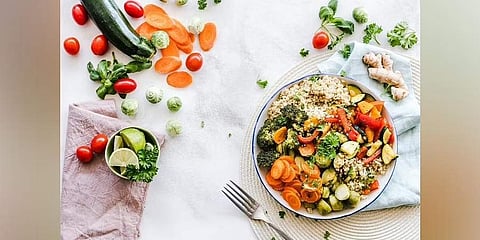
- LIFESTYLE
- FASHION
- FOOD
- ENTERTAINMENT
- EVENTS
- CULTURE
- VIDEOS
- WEB STORIES
- GALLERIES
- GADGETS
- CAR & BIKE
- SOCIETY
- TRAVEL
- NORTH EAST
- INDULGE CONNECT

When it comes to healthy eating, people are often confused about what and how much to eat. The simplest way to ensure you’re eating right is by creating a rainbow on your plate. You can do this by making your plate as colourful as possible with fruits, vegetables and herbs. Include red, orange, yellow, green, blue… pretty much all the colours of a rainbow. The diversity ensures you get enough antioxidants, vitamins and minerals for good health.
Why are different colours important? Phytochemicals and natural bioactive compounds are responsible for giving fruits and vegetables their colour. They are all disease-fighting in nature and keep heart disease, hypertension, blood pressure, vision loss and even cancer at bay. Here’s breaking down the colours for you.
Lycopene (red): Reduces the risk of breast and prostate cancer, and boosts heart, brain, and eye health. Make the most of this chemical by adding watermelon, tomatoes, strawberries, red peppers and grapefruit to your diet.
Beta-carotene (orange): A precursor to Vitamin A, this chemical has anti-cancer properties. It reduces inflammation, strengthens the immune system, and boosts vision. Foods rich in beta-carotene include carrots, apricot, yellow pumpkin and sweet potato.
Vitamin C and flavonoids (yellow): These foods are rich in antioxidants and inhibit the growth of tumour cells. Vitamin C and flavonoids detoxify the body, boost immunity, reduce inflammation, and improve heart health. Vitamin C is found in citrus fruits such as oranges, lemons, kale, strawberries and broccoli.
Folate (dark green): These foods help build healthy cells and genetic material. Rich in iron, they help in maintaining healthy haemoglobin levels. Folate-replete foods are also rich in chlorophyll, a plant pigment that helps increase oxygenation in the blood and acts as a blood purifier. Add asparagus, legumes, leafy greens, Brussel sprouts and beetroot leaves to your plate.
Indoles and lutein (light green): Rich in sulphur, indoles eliminate excess estrogen from the body, and also support eye health. Foods containing indoles are cabbage, Brussels sprouts, kale, mustard greens and broccoli. Allyl sulphides and indoles are known to have anti-carcinogenic properties and decrease the risk of cardiovascular diseases. Garlic, shallots and onions have high amounts of Allyl sulphides.
Anthocyanins (blue-purple): Anthocyanins destroy free radicals, reduce inflammation, and are beneficial for the brain. These are found in foods such as eggplant, blueberries, plums, cherries and grapes.
Resveratrol (pink): This compound helps decrease estrogen production and boosts heart and brain health. Foods rich in resveratrol are peanuts, dark chocolate, cranberries and grapes.
Fibre (brown): Fibre offers a wide range of health benefits. It helps regulate sugar levels, aids digestive health, helps in lipid control, reduces blood sugar spikes, and assists in weight management. Add whole wheat, barley, bran, chickpeas and lentils to your diet.
Ways in which you can create a rainbow on your plate:
✥ Stir-fried or sautéed vegetables
✥ Salad
✥ Chopped vegetables in lentils
✥ Soups with different-coloured vegetables
✥ Rainbow sandwiches
✥ Vegetable sticks with healthy dips
✥ Pulav with green peas, beetroot, carrots and beans
Coutinho practises in the field of Holistic Nutrition - Integrative and Lifestyle Medicine, Founder of Luke Coutinho Holistic Healing Systems.